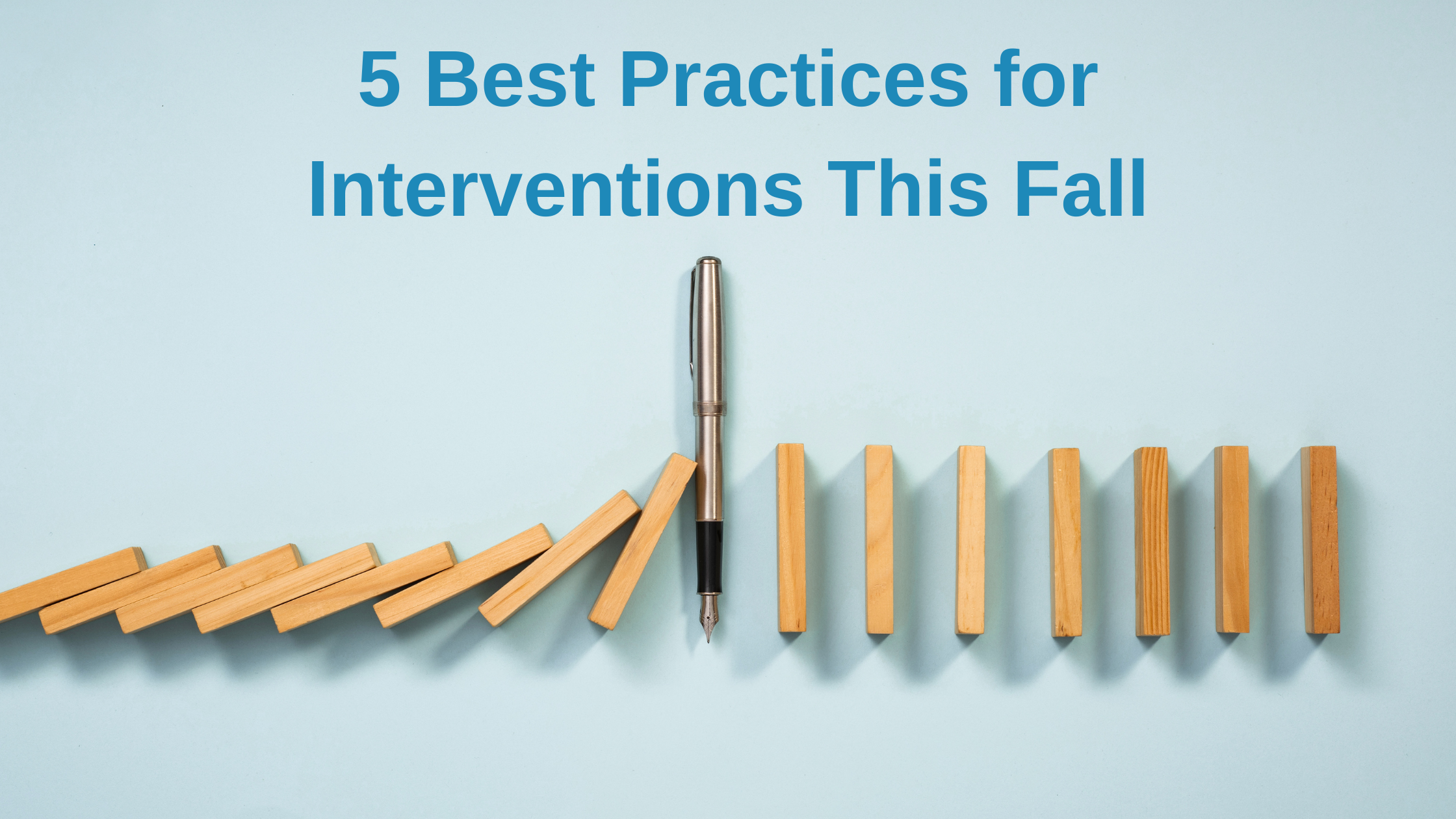
The temperature is dropping and leaves are turning shades of red, orange and yellow. New school clothes are looking a little more worn and first day haircuts have all but disappeared. Schools have been in session for a little while. For many students, the beginning of the school year marked the first time they had been in a classroom for over a year. The first few weeks of schools were marked with excitement in classrooms and homes across the country.
As we head into the Fall, that beginning of the year excitement has started to wear off and the day to day routines of school are falling back into a familiar cadence. The first assessments have been administered and the results are not surprising. Many students are struggling in a lot of different ways. Designing and implementing interventions will need to be a top priority for teachers and school leaders across the country and around the world.
Unfortunately, most intervention plans are not rooted in data or research. They are piece-mieled together in hopes that something sticks. We need to be wary about throwing darts in the dark. Intervention plans must be well thought out, defined, and targeted to meet the individual needs of students.
As you and your colleagues look for ways to support student growth, here are 5 best practices for interventions this fall:
-
-
Use a Variety of Ability and Academic Data
Assessment data is critical to identifying which students need additional support and in which areas. Schools need to gather both cognitive profile insights and academic benchmarks in the Fall to ensure student baselines. This data needs to be organized and drilled down in the following manner:
-
- By District / School
- By Class and Cohort
- By Student
- By Subject and Standard
School leaders need to get a birds-eye view of how students are performing in individual classes in order to determine if instruction changes need to occur. Individual student data needs to be collected to determine which students need additional support. This data needs to be organized by subject and key learning outcomes for each level. Students intervention profiles can then be created that indicate which students need support for each specific standard. It should be noted that “priority” standards should be heavily used to determine intervention steps. “Priority” standards are those that are the most prevalent in the content, are cyclical in nature and are revisited throughout the year, cross-curricular, and extend to other courses.
-
-
Observational Data is Key to Contextual Understanding
While collecting student ability and achievement data is important, we must not take away the power of teachers’ observational data. Some students might pull off a good score on a multiple choice, standardized test, but might fall short when completing competency-based assessment. ThoughtCo defines unobtrusive observations as a way to minimize a major problem in social research, which is how a subject’s awareness of the research project affects behavior and distorts research results. Teachers need to use a variety of assessments, including their own professional observations to determine a child’s proficiency level. In order to collect observational data, it is essential that teachers differentiate both their instruction and the activities that students will participate in. Unobtrusive observations occur when the students do not know that they are being observed. The purpose behind this method is so that students do not change their behavior during observations. Some ideas include group work, think-pair-shares, oral reports, project-based learning, and competency-based assessments. -
Interventions Should Be in Small Groups and Last 6 Weeks
Interventions need to be comprehensive and long enough to ensure that a child has reached mastery of the deficient standard. While a tier 1 intervention might be a quick reteach in the moment, tier 2 interventions should last around 6 weeks to ensure that students have enough time to relearn the content. During those six weeks, students should engage in intervention 2-3 days per week for at least 30 minutes per day. This will allow for 12-18 touch points over the six week period. Vaughn and colleagues (2003) report that 1:1 or small group work of a ratio of 1:3 allows for the most growth in a reteach or intervention setting. Edsurge reports that intentionally making strong connections with every student creates a learning atmosphere that’s built on empathy and understanding. Frequent checks to ensure that the student(s) are heading in the right direction will be important. Corrections will need to be made if students are not progressing towards intended results.
-
Schedule Intervention Time During the School Day
Many schools run academic interventions before or after schools as school schedules are impacted and without room to insert an intervention period. Furthermore, physical space can also be an issue in schools as open rooms can be hard to come by. However, running interventions before and after school can wear both students and teachers down. It is important to remember that some students must leave their homes early in the morning to travel to school. Some students catch the morning bus between 6 and 6:30am daily, only to return between 5 and 5:30pm. Placing interventions before or after school might eliminate opportunities for students who take school or public transportation to school. For teachers, it makes a long day of teaching even longer. Most schools have some room in their instructional minutes allotment. Shaving off a few minutes per class period at middle and high schools will allow for the creation of an intervention period for students who need extra support. Students who do not need the support can use the time for study hall or content expansion / exploration. -
Interventions Should Also Address Behavioral Concerns
Academic concerns are usually the focal point of most interventions. However, it is vital that schools also address behavioral concerns. Interventions of this nature can include social groups, one-on-one check-ins with teachers or counselors, role playing, and de-escalation strategies. Many behavioral concerns being seen in schools this year can be linked back to over a year of social distancing, missed life milestones, and the feeling of isolation. For our younger students, many of them don’t remember what school was like pre-pandemic. According to Edsource, educators expect more disruption and difficulties from some students due to the pandemic. We need to be proactive and set up support groups and counseling sessions for students most affected by the pandemic and everything that it brought into their lives or took away from them.
Vaughn S, Linan-Thompson S, Kouzekanani K, Pedrotty Bryant D, Dickson S, Blozis SA. Reading Instruction Grouping for Students with Reading Difficulties. Remedial and Special Education. 2003;24(5):301-315. doi:10.1177/07419325030240050501
-





